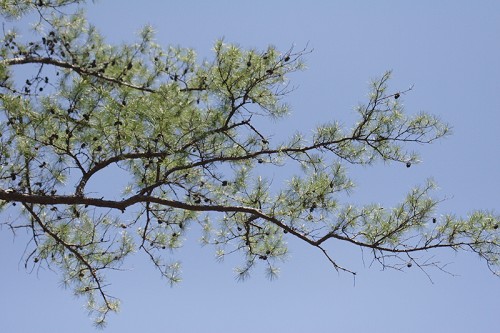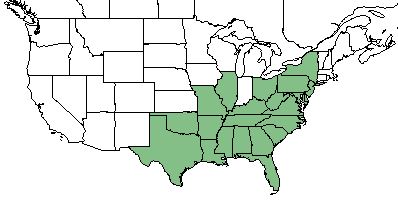Difference between revisions of "Pinus echinata"
(→Ecology) |
|||
| Line 1: | Line 1: | ||
{{italic title}} | {{italic title}} | ||
| + | Common names: Shortleaf pine <ref name= "USDA"> [https://plants.usda.gov/core/profile?symbol=CEAM USDA Plant Database]</ref> | ||
<!-- Get the taxonomy information from the NRCS Plants database --> | <!-- Get the taxonomy information from the NRCS Plants database --> | ||
{{taxobox | {{taxobox | ||
| Line 34: | Line 35: | ||
Ideal habitats include dry rocky ridges, slopes, sandhills, old fields, forests, and generally xeric sites but can occur in mesic to wet sites. <ref name= "Weakley"> Weakley, A. S. (2015). Flora of the Southern and Mid-Atlantic States. Chapel Hill, NC, University of North Carolina Herbarium.</ref> | Ideal habitats include dry rocky ridges, slopes, sandhills, old fields, forests, and generally xeric sites but can occur in mesic to wet sites. <ref name= "Weakley"> Weakley, A. S. (2015). Flora of the Southern and Mid-Atlantic States. Chapel Hill, NC, University of North Carolina Herbarium.</ref> | ||
| + | |||
| + | Longleaf pine regions are ideal environments for the ''P. echinata'' of shortleaf pine, where they share a dominance over the area. <ref name= "cipollini''>Cipollini, M. L., et al. (2012). "Herbaceous plants and grasses in a mountain longleaf pine forest undergoing restoration: a survey and comparative study." Southeastern Naturalist 11: 637-668.</ref> Much of these ecosystems thrive with winter burns, particularly in old-fields. <ref name= "clewell" >Clewell, A. F. (2014). "Forest development 44 years after fire exclusion in formerly annually burned oldfield pine woodland, Florida." Castanea 79: 147-167.</ref> | ||
<!--Natural communities, human disturbed habitats, topography, hydrology, soils, light, fire regime requirements for removal of competition, etc.--> | <!--Natural communities, human disturbed habitats, topography, hydrology, soils, light, fire regime requirements for removal of competition, etc.--> | ||
===Phenology=== | ===Phenology=== | ||
| Line 44: | Line 47: | ||
===Fire ecology=== | ===Fire ecology=== | ||
''P. echinata'' has an extremely high tolerance for fire. <ref name= "USDA"> [https://plants.usda.gov/core/profile?symbol=CEAM USDA Plant Database]</ref> | ''P. echinata'' has an extremely high tolerance for fire. <ref name= "USDA"> [https://plants.usda.gov/core/profile?symbol=CEAM USDA Plant Database]</ref> | ||
| + | |||
| + | Instances of fire or prescribed burning will promote regeneration of the shortleaf pine. <ref name= "Elliot">Elliott, K. J. and J. M. Vose (2005). "Effects of understory prescribed burning on shortleaf pine (Pinus echinata Mill.)/mixed-hardwood forests." Journal of the Torrey Botanical Society 132: 236-251.</ref>. COntinued prescribed burning in a region can make for ideal habitats for shortleaf pine forests instead of hardwoods being predominate in the region. <ref name= "garren">Garren, K. H. (1943). "Effects of fire on vegetation of the southeastern United States." Botanical Review 9(9): 617-654.</ref> | ||
<!--Fire tolerance, fire dependence, adaptive fire responses--> | <!--Fire tolerance, fire dependence, adaptive fire responses--> | ||
<!--===Pollination===--> | <!--===Pollination===--> | ||
| − | <!--===Use by animals===--> <!--Herbivory, granivory, insect hosting, etc.--> | + | <!--===Use by animals===--> |
| + | Shortleaf pines can provide habitats for the red-cockaded woodpecker; efforts at restoring the woodpeckers population in these environments include reintroduction of fire and constructing stands for the birds nesting. These prescribed burned shortleaf pine woods also provide a greater increase in small mammals in the region. <ref name= "USDA workshop" > The Role of Fire in Nongame Wildlife Management and Community Restoration: Traditional Uses and New Directions, Proceedings of a Special Workshop, 2000 </ref> | ||
| + | <!--Herbivory, granivory, insect hosting, etc.--> | ||
<!--==Diseases and parasites==--> | <!--==Diseases and parasites==--> | ||
Revision as of 16:25, 6 June 2018
Common names: Shortleaf pine [1]
| Pinus echinata | |
|---|---|

| |
| Photo by John Gwaltney hosted at Southeastern Flora.com | |
| Scientific classification | |
| Kingdom: | Plantae |
| Division: | Magnoliophyta - Flowering plants |
| Class: | Magnoliopsida - Dicots |
| Order: | Pinales |
| Family: | Pinaceae |
| Genus: | Pinus |
| Species: | P. echinata |
| Binomial name | |
| Pinus echinata Mill. | |

| |
| Natural range of Pinus echinata from USDA NRCS Plants Database. | |
Contents
Taxonomic Notes
Synonym: P. mitis (michaux)
Variety: none
Description
P. echinata is a perennial tree of the Pinaceae family that is native to North America. [1]
Distribution
Native to the southeastern Unites States, p. echinata is found as far north as New York and as far west as Texas and Oklahoma. [1]
Ecology
Habitat
P. echinata has adapted to coarse, fina and medium textured soils. It has a medium drought tolerance. It has a high intolerance to shade.[1]
Ideal habitats include dry rocky ridges, slopes, sandhills, old fields, forests, and generally xeric sites but can occur in mesic to wet sites. [2]
Longleaf pine regions are ideal environments for the P. echinata of shortleaf pine, where they share a dominance over the area. [3] Much of these ecosystems thrive with winter burns, particularly in old-fields. [4]
Phenology
Flowering occurs in March. [5]
Seedig begins in summer and will last through fall. [1]
Fire ecology
P. echinata has an extremely high tolerance for fire. [1]
Instances of fire or prescribed burning will promote regeneration of the shortleaf pine. [6]. COntinued prescribed burning in a region can make for ideal habitats for shortleaf pine forests instead of hardwoods being predominate in the region. [7] Shortleaf pines can provide habitats for the red-cockaded woodpecker; efforts at restoring the woodpeckers population in these environments include reintroduction of fire and constructing stands for the birds nesting. These prescribed burned shortleaf pine woods also provide a greater increase in small mammals in the region. [8]
Conservation and Management
Pinus echinata is considered endangered in Illinois[1]
Cultivation and restoration
Photo Gallery
References and notes
- ↑ 1.0 1.1 1.2 1.3 1.4 1.5 1.6 USDA Plant Database
- ↑ Weakley, A. S. (2015). Flora of the Southern and Mid-Atlantic States. Chapel Hill, NC, University of North Carolina Herbarium.
- ↑ Cipollini, M. L., et al. (2012). "Herbaceous plants and grasses in a mountain longleaf pine forest undergoing restoration: a survey and comparative study." Southeastern Naturalist 11: 637-668.
- ↑ Clewell, A. F. (2014). "Forest development 44 years after fire exclusion in formerly annually burned oldfield pine woodland, Florida." Castanea 79: 147-167.
- ↑ Pan Flora
- ↑ Elliott, K. J. and J. M. Vose (2005). "Effects of understory prescribed burning on shortleaf pine (Pinus echinata Mill.)/mixed-hardwood forests." Journal of the Torrey Botanical Society 132: 236-251.
- ↑ Garren, K. H. (1943). "Effects of fire on vegetation of the southeastern United States." Botanical Review 9(9): 617-654.
- ↑ The Role of Fire in Nongame Wildlife Management and Community Restoration: Traditional Uses and New Directions, Proceedings of a Special Workshop, 2000